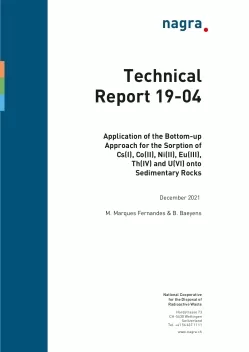
Technical Report NTB 19-04
Application of the Bottom-up Approach for the Sorption of Cs (I), Co (II), Ni(II), Eu(III), Th(IV) and U(VI) onto Sedimentary Rocks
Abstract
The safety assessment for the general licence application in the framework of the Swiss Sectoral Plan for Deep Geological Repositories will require a state-of-the-art sorption database. It is foreseen to apply a simplified component additive approach, the so-called bottom-up approach, for the development of the sorption database. This approach allows to calculate directly the solid-liquid distribution ratios (Kd values) for radionuclides by considering aqueous speciation, solubility and concentration-dependent adsorption for site-specific argillaceous rock-porewater systems. Therefore, testing this approach is of key importance to verify its robustness and validate its applicability.
The sorption of radionuclides in natural multi-mineral environments such as geological rock formations is by nature too complex to be easily predicted. The bottom-up approach assumes that in the case of clay-rich environments, retention is controlled by adsorption onto 2:1 clay minerals (e.g. montmorillonite, illite, or illite/smectite mixed layers). In this report, the predictive capability of two in-house adsorption models developed for illite, i.e., the generalised Cs sorption model and the 2 site protolysis non electrostatic surface complexation and cation exchange model, are assessed on realistic geochemical systems. This is achieved by blind predicting adsorption isotherms of Cs(I), Ni(II), Co(II), Eu(III), Th(IV) and U(VI) measured on different rocks (with different clay mineral contents) with the appropriate sorption model, scaled to the 2:1 clay mineral or illite content and by considering the aqueous speciation of the element in the respective porewater. In this approach the sorption model on illite is considered to be also representative for the illite/smectite mixed layers.
In view of the uncertainties related to the complexity of the natural rocks and to the thermodynamic sorption modelling, it can be concluded that the outcome of this modelling exercise is quite satisfying. For Cs(I) and Th(IV), experimental isotherms are very well re-produced. The Eu(III) sorption isotherms for almost all rocks are systematically slightly underestimated, even so the general prediction is rather good. The formation of ternary Eu-carbonate surface complexes, not considered in the modelling, and/or additional partitioning of Eu(III) into calcite might be responsible for the enhanced sorption. In the case of U(VI), the blind predictions are mostly good except for the carbonate-rich Helvetic Marl for which sorption is overpredicted. Aqueous U(VI) carbonate complexes, particularly the non-sorbing ternary uranyl-calcium-carbonate complexes, strongly reduce the sorption of U(VI).
The maximum deviation between blind prediction and experimental data is observed for the divalent transition metals Co and Ni. In the higher equilibrium concentration range of the isotherms, the calculations clearly underestimate the sorption for both metals on most rock samples. The reason for this discrepancy is likely the formation of Ni/Co surface precipitates, not considered in the sorption model since it is not an adsorption mechanism. For the application of the approach in a safety assessment, processes leading to an enhanced uptake of divalent transition metals would be beneficial; however, such high radionuclide releases are not anticipated in the far field of a deep geological repository for radioactive waste. A major contribution of calcite in the retention of divalent cations cannot be confirmed based on this study; however, it is known that divalent transition elements are strongly partionned into calcite.
This study demonstrates that the simplified bottom-up approach provides a fairly good methodology for the adsorption of a number of metals and their appropriate chemical analogues, with oxidation states from I to IV and VI, on clay-rich rocks. For the majority of relevant radionuclides to be considered in a safety assessment, this approach can therefore be applied. In the case where the blind prediction underestimates the observed sorption data (e.g. divalent transition metals at high equilibrium concentrations, or in the case of Eu), the bottom-up approach will calculate conservative Kd values for the safety assessment. On the other hand, for the few cases found in this study where the blind prediction overestimates the measurements, the lower limit uncertainty values can be regarded as reliable, as shown in this study. In clay-poor rocks, other minerals, especially calcite, might (partly) control the retention of given metals. If calcite is the dominant mineral in certain sedimentary rocks, a sorption database for calcite has to be applied.
